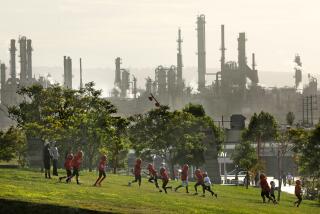Once Made Parts for Model T : Ford Closing 65-Year-Old N.Y. Radiator Plant
GREEN ISLAND, N.Y. — After 63 years, the production lines at one of Henry Ford’s oldest plants will grind to a halt this month, and the factory that once made radiators for the Model T will close its doors for good.
For the past 2 1/2 years, Ford employees who didn’t accept transfers to Plymouth, Mich., have dealt with the grim reality that their jobs would soon be gone.
“I have to relate it to a person who has cancer. You have that hope that you’re going to be cured, and finally you realize that there’s no hope. It’s all gone,” said James Roti Roti, president of United Auto Workers Local 930.
The radiator and heater-core plant, which employed nearly 1,500 in 1973, is scheduled to close Nov. 30 in this upstate community of less than 3,000, about 150 miles north of New York City.
Ford is switching to aluminum radiators and heater cores instead of using copper and brass. They will be made in Michigan.
The historic plant--on a Hudson River site handpicked by Henry Ford during a 1916 camping trip--will be gutted and sold for $5 million to $6 million, said John C. Hazlett, Ford’s plant area manager.
A stone displayed at the plant with the initials of Ford and his camping companions--Thomas Edison, John Burroughs and Harvey Firestone Sr.--may be donated to a museum, Hazlett said.
Opposed Concentration
When Ford built the Green Island plant, one of nine hydropower plants he erected by 1925, the auto maker believed that building factories in rural areas would allow farmers to work during winter months at his plants.
“Manufacturing, instead of being concentrated in a few centers, should be and can be widely distributed,” Ford wrote.
How the members of Local 930 wish Ford’s statement had withstood the test of time. But company officials determined that to convert the Green Island plant, which had revenue totaling more than $67.9 million in 1987, to an aluminum radiator facility would not be worth the cost.
It would cost $3 million more annually to make the products in New York than in Michigan, Hazlett said.
Workers say that perhaps the one blessing of their dismal situation was that they had plenty of advance warning about the shutdown. The time helped some plan and gave others a chance to work overtime and save money.
It also gave them more time to hold false hopes that things would turn around.
First, union members fought to keep the plant open, even going so far as to leaflet shareholders at a Detroit meeting in 1986.
They hoped for a new Ford product, a new owner, an employee-owned factory--and then set their minds on protecting as best they could those who would inevitably be jobless.
Wait for Shutdown
By October, radiator assembly line equipment had been torn out of the 287,000-square-foot plant--much already carted away. Employees still working on heater core lines not far from the windows that look out on the Hudson River spoke wistfully as they looked at the empty spaces where their friends once worked.
“How can you feel, you know? You can’t really feel anything. You just wait for it (the shutdown) to happen,” said Dennis Bourdeau, 46, a 22-year plant veteran who doesn’t know what he’ll be doing for a living as of Dec. 1.
“Everybody was hoping until the last minute,” Bourdeau said.
Productivity never dropped, even after layoffs and the shutdown were announced. There was no sabotage.
Most of the workers, whose average age is 50, have about 20 years of service and earn $14 to $17 an hour, just wanted to make it to retirement, said Ray Vaillancourt, 45, who has worked there 23 years.
Vaillancourt opted not to take the transfer offer to Michigan and planned to make his part-time job as a charter bus driver full time.
Workers aren’t bitter, Vaillancourt said.
The mood in the plant, Bourdeau said, is mostly just disappointment.
“We have met our schedules, and our quality has actually improved year over year for the last four or five years,” conceded Hazlett, the plant area manager.
More to Read
Inside the business of entertainment
The Wide Shot brings you news, analysis and insights on everything from streaming wars to production — and what it all means for the future.
You may occasionally receive promotional content from the Los Angeles Times.










